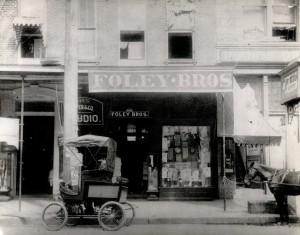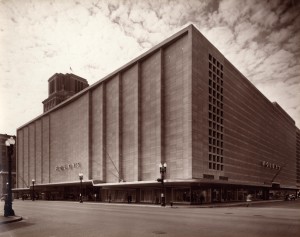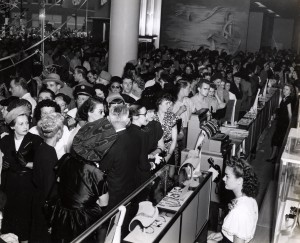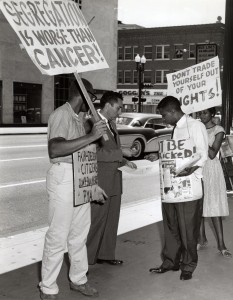

Foley Bros. on Main St. (1906) – available for high resolution download at our Digital Library
Too often the city of Houston has a tendency to discard or wash away its history. The perpetual buzz of construction around the sprawling metropolis has become our recurring soundtrack. We seem to relish in pulling down long-standing authenticity so we can build the artificial over it again with a restlessness that results in a sort of amnesia for long-time residents and a disconnect for newly-arriving transplants.
In short, Houston is a city where it can be difficult to hold onto the thin threads of history.
For just over a century the Foley’s Department Store served as a cornerstone in Houston, serving the needs of the population beyond simple commercial interests. Paul and James Foley founded their Dry Goods Company in 1900. By the twenty-first century, the shifting sands of business had seen Macy’s take over operations of the iconic building down on Main Street and, shortly thereafter, the registers ceased their chiming as Houston’s old department store was shuttered. In-between those one hundred or so years, however, the Foley’s Department Store would be witness to and participant in the evolution and growth of Houston — and we have the records to prove it.
Part of the Houston History Archives, the Foley’s Department Store Records may seem like an unlikely source for the interested scholar. As one of the rare long-standing entities in Houston, however, the store’s records provide insight across a number of disciplines and attract scholars of different feathers. With materials representing the operations of marketing, legal, financial, and public relations departments inside Foley’s, there is a little something for everyone. Some are interested in studying the process of desegregation in the store’s dining facilities. Others may be inclined to watch the changing trends in fashion. Still others will want to look at the evolution of advertising and consumerism as it explodes in the post-World War II years. The construction of the “store of tomorrow” will no doubt please those interested in architecture. Studying transit and urban sprawl? Foley’s planned expansions into the developing Houston suburbs are documented in studies analyzing, among other things, transportation.
This collection is a genuine cornucopia for the famished scholar of Houston history.
Given the recklessness with which we treat our history at times, those more interested in a simple look into Houston’s past will feel fortunate to be able to view it from this singular window over these many years (Never you mind that the revolutionary building design of Kenneth Franzheim wasn’t real big on windows!).

Modernism as showcased in the Foley’s building – the lack of windows serving as accents to the climate-controlled function
In typical Houston fashion, the late twentieth century saw a new “uptown” shopping district being developed out west of downtown. The Galleria would go on to become synonymous with Houston, its commercial industry, and tourism. As other downtown power players jumped at the chance to leave their urban center, Foley’s seemed to understand that the view from Main Street is different than that from the fringe.
We invite you to come share this historic view of our city.

